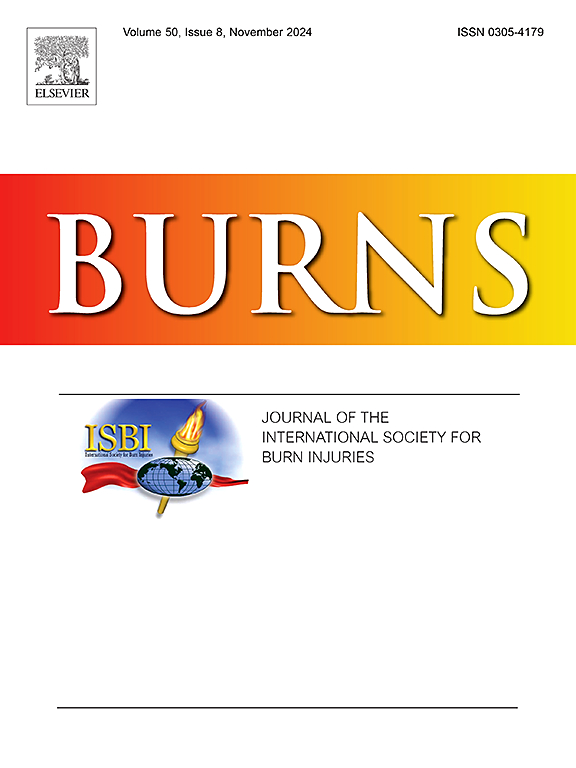Association between platelet-to-lymphocyte ratio at admission and short-term mortality in severe burn patients: a meta-analysis
IF 3.2
3区 医学
Q2 CRITICAL CARE MEDICINE
引用次数: 0
Abstract
Background
The platelet-to-lymphocyte ratio (PLR) reflects a pro-inflammatory state, which has been related to the severity and poor prognosis in severe burn patients. However, the results of the previous studies were not consistent. This meta-analysis aims to evaluate the relationship between PLR at admission and short-term mortality in severe burn injuries.
Methods
A comprehensive search was conducted in PubMed, Embase, Web of Science, Wanfang, and CNKI for studies published until September 9, 2024. Cohort studies assessing PLR and short-term mortality in severe burn patients were included. Mean difference (MD) for PLR between survivors and nonsurvivors of severe burn, and odds ratios (OR) for short-term mortality (during hospitalization or within 90 days) comparing between patients with a high versus a low PLR at admission were summarized.
Results
Eleven cohort studies with 4,515 patients were included. The analysis revealed that PLR at admission was significantly lower in survivors compared to nonsurvivors (MD: -14.17; 95% confidence interval [CI]: -28.01 to -0.34; p = 0.04). Subgroup analyses showed consistent findings across various demographics, including age, sex, total body surface area affected by burn, proportion of patients with inhalation injury, follow-up duration, and different study quality scores (p for subgroup difference all > 0.05). Furthermore, a high PLR at admission was associated with an increased risk of short-term mortality (OR: 1.37; 95% CI: 1.16 to 1.63; p < 0.001).
Conclusions and recommendations
A high PLR at admission is associated with an increased risk of short-term mortality in severe burn patients.
严重烧伤患者入院时血小板与淋巴细胞比率与短期死亡率之间的关系:一项荟萃分析
血小板与淋巴细胞比值(PLR)反映了一种促炎状态,与严重烧伤患者的严重程度和不良预后有关。然而,以往的研究结果并不一致。本荟萃分析旨在评估入院时PLR与严重烧伤患者短期死亡率之间的关系。方法综合检索PubMed、Embase、Web of Science、万方、中国知网(CNKI)截至2024年9月9日已发表的研究。纳入了评估严重烧伤患者PLR和短期死亡率的队列研究。总结了严重烧伤幸存者与非幸存者之间PLR的平均差异(MD),以及入院时高PLR与低PLR患者之间短期死亡率(住院期间或90天内)的比值比(OR)。结果纳入了6项队列研究,共4515例患者。分析显示,与非幸存者相比,幸存者入院时的PLR显著降低(MD: -14.17;95%置信区间[CI]: -28.01 ~ -0.34;P = 0.04)。亚组分析显示了不同人口统计数据的一致结果,包括年龄、性别、烧伤影响的体表总面积、吸入性损伤患者比例、随访时间和不同的研究质量评分(p表示亚组差异all >;0.05)。此外,入院时的高PLR与短期死亡风险增加相关(OR: 1.37;95% CI: 1.16 ~ 1.63;p & lt;0.001)。结论和建议入院时的高PLR与严重烧伤患者短期死亡风险增加相关。
本文章由计算机程序翻译,如有差异,请以英文原文为准。
求助全文
约1分钟内获得全文
求助全文
来源期刊

Burns
医学-皮肤病学
CiteScore
4.50
自引率
18.50%
发文量
304
审稿时长
72 days
期刊介绍:
Burns aims to foster the exchange of information among all engaged in preventing and treating the effects of burns. The journal focuses on clinical, scientific and social aspects of these injuries and covers the prevention of the injury, the epidemiology of such injuries and all aspects of treatment including development of new techniques and technologies and verification of existing ones. Regular features include clinical and scientific papers, state of the art reviews and descriptions of burn-care in practice.
Topics covered by Burns include: the effects of smoke on man and animals, their tissues and cells; the responses to and treatment of patients and animals with chemical injuries to the skin; the biological and clinical effects of cold injuries; surgical techniques which are, or may be relevant to the treatment of burned patients during the acute or reconstructive phase following injury; well controlled laboratory studies of the effectiveness of anti-microbial agents on infection and new materials on scarring and healing; inflammatory responses to injury, effectiveness of related agents and other compounds used to modify the physiological and cellular responses to the injury; experimental studies of burns and the outcome of burn wound healing; regenerative medicine concerning the skin.
 求助内容:
求助内容: 应助结果提醒方式:
应助结果提醒方式:


